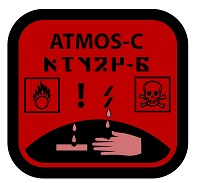Insidious Atmosphere
A Insidious Atmosphere is similar to a corrosive atmosphere, but extreme conditions cause the corrosive effects to defeat any protective measures in two to twelve hours.
Description (Specifications)[edit]
The term insidious atmosphere is quite sufficient for the layman, but it is far more descriptive if a starship crew person reports that a the ship is about to debark to a world with a hydrogen atmosphere where subtle hydrogen seepage could cause a dangerously explosive air mix inside a crew person's vacc suit, which could be ignited by a spark from the suit's electrical system. [1]
An Insidious atmosphere is so dangerous that it will defeat a vacc suit after just a few hours and kill the sophont inside it. Venus, with its incredible high pressure, high temperature atmosphere comes into this latter category. [2]
Extreme Atmospheres[edit]
Extreme Atmospheres: Some of the more difficult atmosphere types to explain and describe are the 'extremes', types A, B and C which equate to Exotic, Corrosive and Insidious.
- Whereas the Very Thin, Thin, Standard and Dense atmospheres are generally Earth-like in pressures with Earth-like gasses (Nitrogen-Oxygen-Carbon Dioxide mixtures) in a variety of amounts, the 'extremes' are terribly toxic, horribly lethal and utterly alien.
- The three types are really grades of lethality, and an A type and C type atmosphere may actually contain the same poisonous gas, just in different amounts. [3]
Lethality of Extreme Atmospheres Atmo. Code Class Name Danger Remarks A Exotic, Conventional Exotic Atmosphere DANGEROUS A gaseous mixture, which is unbreathable by mainline conventional life sophonts. B Exotic, Conventional Corrosive Atmosphere HIGHLY DANGEROUS Not only a dangerous gaseous mixture, but may have dangerous pressure, and temperature qualities in addition to corrosive (acidic) properties. C Exotic, Conventional Insidious Atmosphere EXTREMELY DANGEROUS Even more dangerous than a Corrosive Atmosphere, with persistently lethal properties that will kill most mainstream sophonts within minutes and destroy most protective equipment within two to twelve hours. D, E, F Exotic, Unusual Unusual Atmosphere DANGEROUS Unusual Atmospheres have livable respiration zones, typically at the heights or depths of a topography. They are rare worlds with very unconventional atmospheres such as Ellipsoid Worlds.
Basic Exotic-Extreme Atmosphere Types[edit]
- Extreme Low Temperature
- Very Thin, Low Temperature
- Very Thin, Moderate Temperature
- Very Thin, High Temperature
- Thin/Standard/Dense, Low Temperature
- Thin/Standard/Dense, Moderate Temperature
- Thin/Standard/Dense, High Temperature
- Very Dense, Low Temperature
- Very Dense, Moderate Temperature
- Very Dense, High Temperature
- Extreme High Temperature
Common Corrosive Atmospheric Components[edit]
Gasses which give an atmosphere an extreme label include carbon dioxide, methane, nitrogen, sulphur, oxygen, hydrogen, ammonia, chlorine and fluorine. These gases are often found in combination with others on the list potentially mixing together with additional dangerous effects into one nasty airborne cocktail! [4]
History & Background (Dossier)[edit]
Insidious (C): An insidious atmosphere is like a corrosive one, but it is so corrosive that it attacks equipment as well. The chief danger in an insidious atmosphere is that the toxic gases will destroy the seals and filters on a traveller’s protective gear. An insidious atmosphere worms its way past protection after just a few hours on average, although vigilant maintenance or advanced protective gear can prolong survival times. [5]
References & contributors (Sources)[edit]
- Marc Miller. Worlds and Adventures (Game Designers Workshop, 1977), 5.
- J. Andrew Keith. Exotic Atmospheres (Game Designers Workshop, 1983), 1-16. (Special Supplement 2 from the periodical Journal of the Travellers' Aid Society 17)
- Marc Miller. Referee's Manual (Game Designers Workshop, 1987), 22.
- Geir Lanesskog. World Builder's Handbook (Mongoose Publishing, 2023), 64-68.Joe Fugate, J. Andrew Keith, Gary L. Thomas. World Builder's Handbook (Digest Group Publications, 1989), 64-68.
- Terrance McInnes, Dave Nilsen. World Tamer's Handbook (Game Designers Workshop, 1994), 11-17.
- Jon F. Zeigler. First In (Steve Jackson Games, 1999), 70,72.
- Paul Drye, Loren Wiseman, Jon F. Zeigler. Interstellar Wars (Steve Jackson Games, 2006), 125-6.
- Gareth Hanrahan. Core Rulebook (Mongoose Publishing, 2008), TBD.
- Marc Miller. T5 Core Rules (Far Future Enterprises, 2013), 409.
- Paul Elliott. The Universal World Profile (Zozer Games, 2016), .
- Matthew Sprange. "Exotic Atmospheres." Journal of the Travellers' Aid Society volume 2 (2019): 60-69.
- ↑ J. Andrew Keith. Exotic Atmospheres (Game Designers Workshop, 1983), 3.
- ↑ Paul Elliott. The Universal World Profile (Zozer Games, 2016), 16.
- ↑ Paul Elliott. The Universal World Profile (Zozer Games, 2016), 16.
- ↑ Paul Elliott. The Universal World Profile (Zozer Games, 2016), 16.
- ↑ Gareth Hanrahan. Core Rulebook (Mongoose Publishing, 2008), 170.
